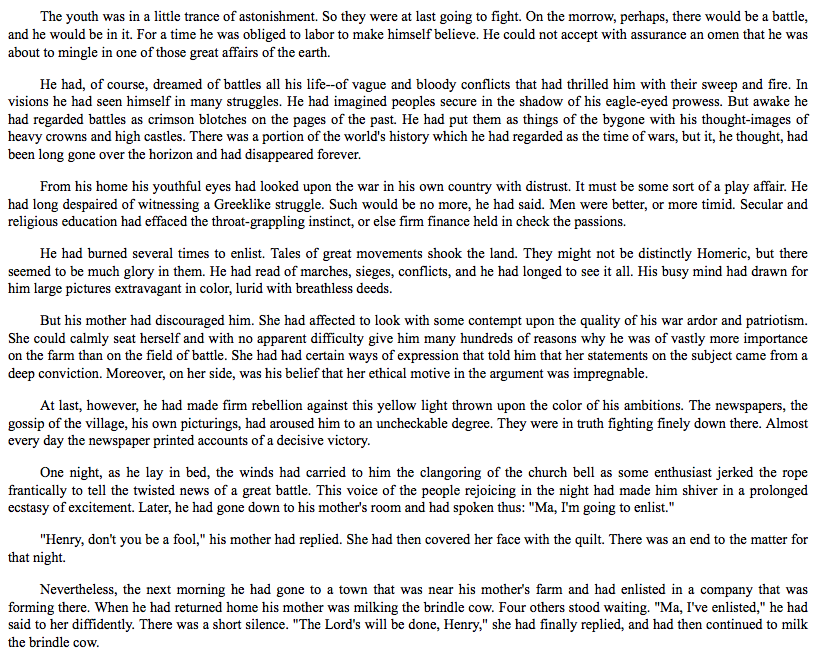Day 1 Student Directions
Student Directions, Part 1 (~50 minutes)
Your assignment:
You will read about historical fiction, listen to an interview with an historical fiction author, and read a picture book and an excerpt of a classic historical fiction novel. You will answer some questions about the sources. Then you will plan, write, and revise your own historical fiction narrative.
Steps you will be following:
In order to plan and compose your narrative, you will:
1) Read an article about elements of historical fiction.
2) Listen to an interview with an historical fiction author.
3) Read a picture book.
4) Read an excerpt from a novel.
5) Answer questions about the sources.
6) Plan, write, and revise your narrative.
Directions for beginning:
You will now read the sources and watch a video. Take notes because you may want to refer back to your notes while writing your narrative. You can refer back to any of those sources as often as you like.
Source 1: Article
Historical Fiction
In historical fiction, setting is the most important literary element. Because the author is writing about a particular time in history, the information about the time period must be accurate, authentic, or both.
Historical fiction books - whether they are picture books, transitional books, or novels - may have characters who are either imaginary or who actually lived during the time period. Settings also may be real or imaginary. The plot events may be documented historical events or they may be fictional. If they are fictional, it means that the author created the events for the telling of the story. The fictional characters, settings, and plot events must be portrayed authentically as if they actually could have happened.
Source 2: Video
Deborah Hopkinson interview
Video clips of a Reading Rockets interview with Deborah Hopkinson who writes historical fiction for children and teens.
http://www.readingrockets.org/books/interviews/hopkinson/
Video clips to view:
Always a Reader 0:46
It’s all in the details 1:52
We’re all discoverers 2:22
History’s boys and girls 1:31
An excerpt from Abe Lincoln Crosses a Creek 2:01
Source 3: Picture Book
An historical fiction narrative in picture book format that is based on real people and events. The book tells the story of the Jubilee Singers, an African-American chorus that travels the country after the Civil War in order to raise money to save a school for freed slaves.
A Band of Angels, by Deborah Hopkinson
Your assignment:
You will read about historical fiction, listen to an interview with an historical fiction author, and read a picture book and an excerpt of a classic historical fiction novel. You will answer some questions about the sources. Then you will plan, write, and revise your own historical fiction narrative.
Steps you will be following:
In order to plan and compose your narrative, you will:
1) Read an article about elements of historical fiction.
2) Listen to an interview with an historical fiction author.
3) Read a picture book.
4) Read an excerpt from a novel.
5) Answer questions about the sources.
6) Plan, write, and revise your narrative.
Directions for beginning:
You will now read the sources and watch a video. Take notes because you may want to refer back to your notes while writing your narrative. You can refer back to any of those sources as often as you like.
Source 1: Article
Historical Fiction
In historical fiction, setting is the most important literary element. Because the author is writing about a particular time in history, the information about the time period must be accurate, authentic, or both.
Historical fiction books - whether they are picture books, transitional books, or novels - may have characters who are either imaginary or who actually lived during the time period. Settings also may be real or imaginary. The plot events may be documented historical events or they may be fictional. If they are fictional, it means that the author created the events for the telling of the story. The fictional characters, settings, and plot events must be portrayed authentically as if they actually could have happened.
Source 2: Video
Deborah Hopkinson interview
Video clips of a Reading Rockets interview with Deborah Hopkinson who writes historical fiction for children and teens.
http://www.readingrockets.org/books/interviews/hopkinson/
Video clips to view:
Always a Reader 0:46
It’s all in the details 1:52
We’re all discoverers 2:22
History’s boys and girls 1:31
An excerpt from Abe Lincoln Crosses a Creek 2:01
Source 3: Picture Book
An historical fiction narrative in picture book format that is based on real people and events. The book tells the story of the Jubilee Singers, an African-American chorus that travels the country after the Civil War in order to raise money to save a school for freed slaves.
A Band of Angels, by Deborah Hopkinson
Source 4: Novel excerpt
The Red Badge of Courage, by Stephen Crane
A boy who dreams of being a hero in battle is confronted by the realities of the Civil War.
The Red Badge of Courage, by Stephen Crane
A boy who dreams of being a hero in battle is confronted by the realities of the Civil War.
End of Day 1

